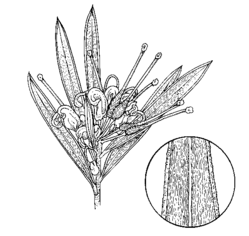Grevillea kedumbensis (McGill.) Olde & Marriott APNI* Synonyms: Grevillea obtusiflora subsp. kedumbensis McGill. APNI*

Description: Lignotuberous shrub 0.2–1 m high.
Leaves often varying greatly in size on a plant, narrow-elliptic to obovate, 1–3 cm long, 1–5 mm wide, margins entire, usually strongly revolute on dried specimens; upper surface coarsely granular; lower surface sericeous.
Conflorescences 12–20-flowered, erect, umbel-like, sessile or almost so. Perianth green to cream, ± glabrous to loosely tomentose outside, bearded inside adjacent to and above the ovary for c. 2 mm; limb subcubic. Gynoecium 12.5–17.5 mm long; ovary villous, sessile; style white to cream, pubescent to loosely and finely villous; pollen presenter lateral, flat.
Follicle sparsely tomentose, very faintly ribbed.
Flowering: Flowers mostly winter and spring, also at other times.
Distribution and occurrence: Grows in sandy loam in dry sclerophyll forest, restricted to an area between the Kedumba Valley and Scotts Main Ra. (near Yerranderie).
NSW subdivisions: CC, CT
Populations assignable to G. mucronulata from the Thirlmere–Couridjah area (CC) are very similar to G. kedumbensis, but have deflexed (not erect) styles in the fruiting stage.
Text by R. O. Makinson
Taxon concept: R.O. Makinson (2000)
APNI* Provides a link to the Australian Plant Name Index (hosted by the Australian National Botanic Gardens) for comprehensive bibliographic data
***The AVH map option provides a detailed interactive Australia wide distribution map drawn from collections held by all major Australian herbaria participating in the Australian Virtual Herbarium project.
|


